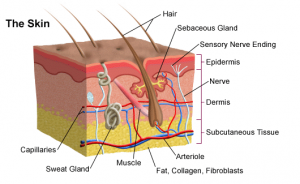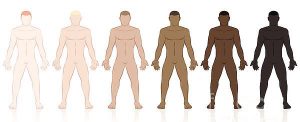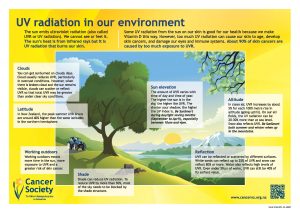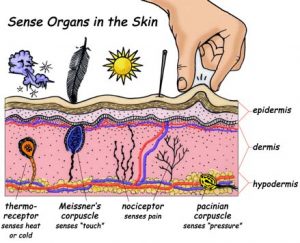The skin’s “sense of touch” is what gives our brains tons of information about the natural environment, including temperature, humidity, and air pressure.
Most importantly, this sense of touch allows us to feel physical pain–a necessity for avoiding injury, disease, and danger.
Skin Anatomy
The skin is composed of several layers, the epidermis on the outside, the dermis in the middle and the subcutis which is the inner layer of our biggest organ.

The very top layer is the epidermis and is the layer of skin you can see. Made of dead skin cells, the epidermis is waterproof and serves as a protective wrap for the underlying skin layers and the rest of the body.
- The epidermis contains melanin, which protects against the sun’s harmful rays and also gives skin its color. When you are in the sun, the melanin builds up to increase its protective properties, which also causes the skin to darken.
- The epidermis also contains very sensitive cells called touch receptors that provide the brain a range of information about the environment the body is in.
The second layer of skin is the dermis. The dermis gives skin its strength and elasticity thanks to fibers of collagen and elastin. This layer contains hair follicles, sweat glands, sebaceous (oil) glands, blood vessels, nerve endings, and a variety of touch receptors.
- Its main role is to feed nutrients to the outer layer and replace the dead skin cells that are shed off the upper layer of the epidermis.
- Blood vessels here help regulate body temperature by increasing blood flow to the skin to allow heat to escape, or by restricting the flow when it’s cold.
- The dermis houses hair follicles and glands with ducts that pass up through the skin. Sweat glands bring down internal temperature through perspiration while ridding the body of the waste fluids urea and lactate.
The skin’s base layer is the subcutis, which includes a seam of fat laid down as a fuel reserve in case of food shortage. It also works as insulation and cushions us from knocks and falls.
- This connective tissue keeps the skin attached to the muscles and tendons underneath.
Skin Color
Skin color is due to melanin, a pigment produced in the epidermis to protect us from the sun’s potentially cancer-causing ultraviolet (UV) rays.
Dark-skinned people produce more numerous and deeper-colored melanin particles. People with the darkest complexions are native to tropical regions, particularly those with few densely forested areas.
Fair skin is an adaptation found in people from northern latitudes where solar rays are relatively weak. But hotter, sunnier environments bring the risk of serious skin damage. Australia and New Zealand have the world’s highest rates of skin cancer.
Our high skin cancer rates are due to:
- high levels of UV radiation – 40% higher than similar latitudes in the northern hemisphere
- low ozone levels, lack of atmospheric pollution
- our outdoor lifestyle
- a high proportion of people with fair skin

Touch – what’s hot, what’s not and how do we know
Our sense of touch is controlled by a huge network of nerve endings and touch receptors in the skin. These are known as the somatosensory system.
This system is responsible for all the sensations we feel – cold, hot, smooth, rough, pressure, tickle, itch, pain, vibrations, and more.
Within the somatosensory system, there are four main types of receptors: mechanoreceptors, thermoreceptors, pain receptors, and proprioceptors.
Touch receptors in the skin are nerve cells that inform the brain about tactile or touch sensations. There are two main types:
Thermoreceptors
These tell you about temperature. Two structures are understood to be used for temperature detection, one detecting cold and the other hot.
- Cold receptors start to perceive cold sensations when the surface of the skin drops below 35*C and are most stimulated when the surface of the skin is at 25*C and are no longer stimulated when the surface of the skin drops below 5*C.
- This is why your feet or hands start to go numb when they are submerged in icy water for a long period of time.
- Hot receptors start to perceive hot sensations when the surface of the skin rises above 30*C and are most stimulated at 35*C after which pain receptors take over to avoid damage to the skin and underlying tissues.
- Thermoreceptors are found all over the body, but cold receptors are found in greater density than heat receptors.
- The highest concentration of thermoreceptors can be found in the face and ears (hence why your nose and ears always get colder faster than the rest of your body on a chilly winter day).

Mechanoreceptors
These tell your body about pushing/pulling forces and body movement and are responsible for translating these physical forces into nerve impulses. Included in this receptor group are:
- Pacinian corpuscles, which detect deep-pressure touch and high-frequency vibrations
- Meissner’s corpuscles, which are responsible for the detection of light touch and are found in the skin of the fingertips, lips, body orifices and nipples
- Merkel’s discs, which provide information relating to pressure and texture and are found in areas like fingertip ridges.
The receptors change chemical, thermal or mechanical responses into electrical signals. The signals travel along axons (the extensions of nerve cells or neurons), which form pathways along which messages travel to areas of the brain that receive and interpret them. In the brain, we interpret sensations using our previous experiences and the properties of the receptors.


